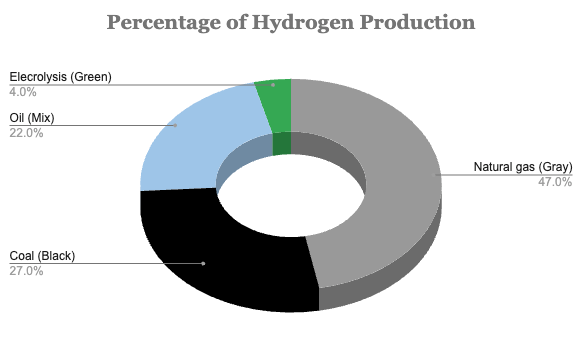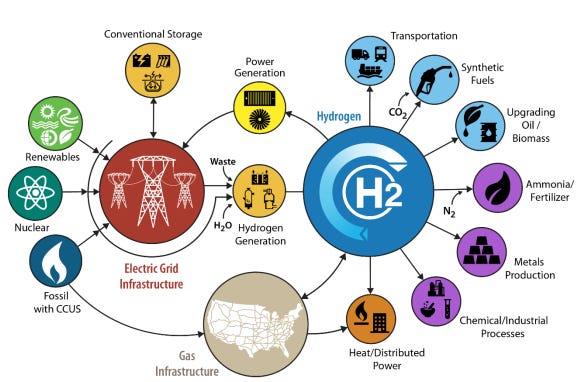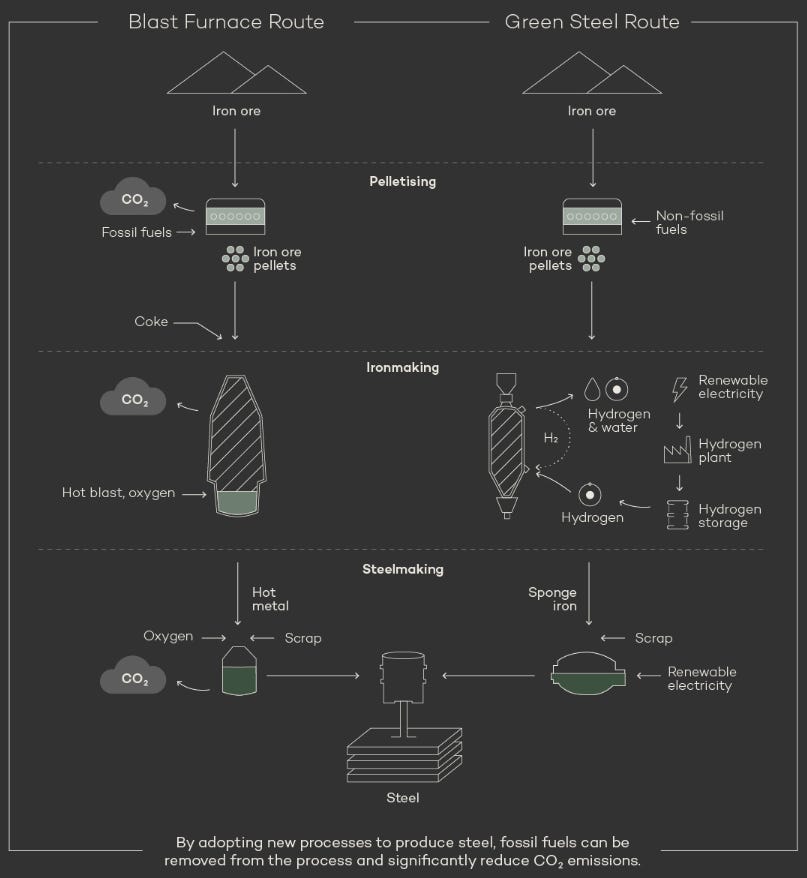Path to 100% Green Hydrogen
Unraveling the challenges and potential of Green Hydrogen as a factor in reaching net-zero emissions.
As we plan to achieve net-zero emissions in the coming decades, green hydrogen seems to be a promising fuel that can be used as a fossil fuel alternative. But there are many barriers the world needs to overcome to produce and use green hydrogen.
Actionable Insights
People have been trying to use hydrogen as fuel since the 1800s, but it was never seen as the primary energy source due to its production cost.
Research by McKinsey estimates that the hydrogen market will generate profits exceeding 2.5 trillion USD by 2050 due to the prediction of a rise in hydrogen demand from 10 to 78 EJ.
Electrolysis is the process used to create clean hydrogen. The process separates water into hydrogen and oxygen but is expensive.
Hydrogen has color ratings - Green, gray, and black. Production of green hydrogen emits no greenhouse gases while producing black hydrogen emits the most greenhouse gases.
The world is focused on using hydrogen in the transportation and power sector to replace fossil fuels and decarbonize Earth.
Cost remains one of the key challenges to overcome to scale green hydrogen production.
Hydrogen was first discovered in 1766. Its first use case as fuel was to fly hot air balloons in 1783. Hydrogen-fuel-based cars were introduced later in the 19th century, but they were of no use due to the availability of cheaper fuel sources.
The concept of electrolysis, a key process in producing green hydrogen, has existed since the 1800s. British scientist Michael Faraday first introduced the laws of electrolysis in the 1830s. However, due to the dominance of fossil fuels, hydrogen wasn't prioritized as an energy carrier during this period.
The oil crises in the 1970s led to an increased interest in alternative energy sources. Hydrogen began to be looked at more seriously as a clean energy carrier. In the 1990s, the 'Hydrogen Economy' concept started to gain traction, proposing hydrogen as a potential solution for reducing carbon emissions.
In the 21st century, scientists continued the research and development of hydrogen technologies. However, the production of green hydrogen was still limited due to high costs and a lack of adequate renewable energy sources. Technological advancements and an increased focus on clean energy sources have made producing green hydrogen more feasible. The cost of renewable energy has now significantly decreased, making the production of green hydrogen more economically viable.
In the 2020s, green hydrogen is considered a key component in achieving global decarbonization goals. Major industries such as transport, manufacturing, and power are looking towards green hydrogen as a potential solution to reduce their carbon emissions. Despite the challenges such as high production costs, storage and transport issues, the potential of green hydrogen is widely recognized.
Research by McKinsey forecasts that the hydrogen market will create more than $2.5 trillion in profits and millions of jobs by 2050. That’s because the demand for hydrogen will rise significantly.
Another research report by IHS Markit reveals that the investment in green hydrogen will exceed 1 billion USD in 2023.
Development of Green Hydrogen
Green hydrogen is produced through a process known as electrolysis, specifically water electrolysis. This process involves separating water into two main elements: hydrogen and oxygen. This method of obtaining green hydrogen is expected to save 830 million tons of CO2 emitted annually when this gas is produced via fossil fuels.
Here’s an infographic by Iberdrola that explains the process of green hydrogen production accurately:
The only limitation of conducting this process is that it's expensive.
A Modern Way to Produce Hydrogen with Methane Pyrolysis
In Methane pyrolysis, thermal energy is applied to CH2 to break the chemical bond between carbon and hydrogen to generate hydrogen and a solid carbon bi-product with no CO2 emission.
Here are the benefits of methane pyrolysis over other methods:
Methane pyrolysis is less polluting than other large-scale methods and can produce hydrogen with zero carbon emissions.
It is less energy intensive as compared to conventional methods of hydrogen production.
It’s a great use of methane that will otherwise pollute the atmosphere.
The process is scalable with a future grid powered by intermittent renewable energy sources.
The by-product of the process, carbon black, is a valuable product with a market size of 13.22 billion USD.
Hydrogen Color Ratings
Hydrogen is given a color grading based on its purity and production method. Research conducted at the end of 2021 by the International Renewable Energy Agency (IREA) found that around 47% of hydrogen production comes from natural gas, 27% from coal, 22% from oil, and only 4% from electrolysis. This means only 4% of the total hydrogen produced was green. 47% of hydrogen was gray, 27% was black, and 22% was a mix of gray, black, and other color grades, except for green. Let’s get to know about these color grades in detail.
🟢 Green Hydrogen
It's the hydrogen produced through the electrolysis of water, where the electricity used in the process comes from renewable sources such as solar or wind power. This process does not emit CO2, hence the term "green." Green hydrogen is the most environmentally friendly method of producing hydrogen, but it's also currently the most expensive due to the high costs of renewable energy and electrolysis equipment.
⚪ Gray Hydrogen
Gray hydrogen is produced through a process called steam methane reforming, where natural gas (methane) is combined with high-temperature steam in the presence of a catalyst to produce hydrogen, carbon monoxide, and a small amount of carbon dioxide. The CO2 is often released into the atmosphere, making this a carbon-intensive process. Gray hydrogen is currently the most common type of hydrogen produced due to its lower costs than green hydrogen.
⚫ Black Hydrogen
Black hydrogen is produced by gasifying coal. This process involves heating coal to a high temperature to produce a mix of hydrogen and carbon monoxide, resulting in significant carbon emissions. "Black" refers to the pollution and high CO2 emissions associated with this process. This method is less common in regions with strong environmental regulations, but it's still used in some parts of the world where coal is abundant and cheap.
Opportunities for Clean Hydrogen to Push For Net-Zero
The demand for green hydrogen will only grow in the coming decade, so it's important to prioritize green hydrogen production where high-efficiency and low-cost options like electrification fail to work. Over time, the growth of clean hydrogen supply across industrial sectors may also lead to the deployment of large-scale distribution infrastructure that connects regions of low-cost supply with large-scale demand.
Importance of Green Hydrogen
DOE Launched H2@Scaler in 2016
H2@Scale Enabler was launched in 2016 by the DOE and its national labs for deep decarbonization. This strategy aims to produce clean hydrogen from diverse domestic resources and use it across sectors. H2@Scale has the potential to reduce greenhouse gas emissions significantly. For example, the DOE estimates that by 2050, H2@Scale could reduce US greenhouse gas emissions by up to 50%. The concept is still in its early stages of development, but it can potentially be a major contributor to the US effort to reduce greenhouse gas emissions and combat climate change.
Here are some of the key benefits of H2@Scale:
Reduces Greenhouse Gas Emissions: Significantly reduce greenhouse gas emissions from various sectors, including electricity generation, transportation, and industry.
Creates Jobs: The development of H2@Scale could create millions of new jobs in the clean energy sector.
Boosts Economic Growth: The H2@Scale economy could boost economic growth by trillions of dollars over the next few decades.
Makes the US More Energy Secure: Help make the US more energy secure by reducing the country's reliance on imported fossil fuels.
Green Hydrogen’s Use in the Transport Industry
According to a survey in 2021, the transportation industry in the US is responsible for 28% of greenhouse gas emissions.
Governments and companies have tried replacing fossil fuels with electric batteries, but hydrogen fuel cells offer significant opportunities for applications requiring long driving ranges, fast fueling, and large or heavy payloads. The DOE works with multiple companies and laboratories on the 21st-century truck partnership to reduce emissions from trucks and buses via safe and cost-effective techniques. Batteries and fuel cells are the two major focus areas of 21 CTP. The DOE also launched the Million Mile Fuel Cell Truck Consortium (M2FCT) in 2020 to enable the fuel cell durability, cost, and performance required for the long-haul heavy-duty truck market.
Apart from roadways, the government also plans to use hydrogen to reduce carbon emissions in the aviation industry. Before Covid-19, the aviation industry was responsible for ~11% of carbon emissions in the US. The primary source to decarbonize the aviation sector is launching Sustainable Aviation Fuels (SAFs), like bio-fuels and power-to-liquid fuels that can replace conventional jet fuels. Keeping this in mind, in 2021, the DOE, DOT, and USAD came together and launched a government-wide Memorandum of Understanding (MOU) that attempts to reduce cost, enhance sustainability, and increase SAF's production and use.
Here’s what the aim behind the MOU is:
Reduce carbon emissions in the aviation industry by 50%
Meeting the goal of supplying sufficient SAF to meet 100% of aviation fuel demand by 2050
Using Green Hydrogen in the Power Sector
Places like hospitals and data centers need electricity 24/7, and these places use diesel as their backup or secondary electricity source. Green hydrogen could replace diesel as a secondary power source. Although backup power usage is low, replacing fossil fuels with green hydrogen is a step in the right direction.
Another sector where hydrogen can be of great use is energy storage. The grid energy storage currently relies on pumped hydropower deployments capable of discharging power for 12 hours or less. Lithium-ion batteries are the faster-growing alternatives of such hydropower deployments, but they can store energy for short periods of time (4 hours or less).
As the grid transforms to 100% clean power, longer-duration energy storage technologies that can discharge for multiple days will be needed, and clean hydrogen is the answer.
Facilities can use electrolyzers to produce hydrogen using excess power on the grid, store it in bulk, and use it when the demand for power rises.
Use of Green Hydrogen to Decarbonize Steel Manufacturing Industry
Energy-related emissions from the manufacturing of iron and steel account for 6.1% of global emissions. Steel is produced mainly by two methods worldwide - Electric arc furnace (EAF) or Blast furnace basic oxygen furnace (BF - BOF). The former uses scrap, and the latter uses coke and iron ore along with scrap to manufacture iron. The best way to decarbonize is through the replacement of fossil fuels used in the process. Where traditional methods use coke - a fossil fuel - in a blast furnace at high temperatures, green steel manufacturing uses green hydrogen produced by water.
Green steel production isn’t cheap because it requires green hydrogen in abundance. Here’s the green hydrogen requirement from the top steel manufacturing country and the estimated renewable sources required.
The Role of Green Hydrogen in Cement Manufacturing
The global cement industry accounts for about 4.5% of the total GHG emissions. Cement is manufactured by a process that produces clinker - a mix of limestone and minerals heated in a kiln and transformed by this heat. When the limestone is converted to clinker, CO2 is released, leading to enormous GHG emissions. So to decarbonize the manufacturing of cement, manufacturers need to capture this CO2 emitted during clinker formation.
The most promising method to do so is the carbon capture and storage (CCS), since it can address both process and energy emissions. But, capturing CO2 emitted from the clinker generation process is expensive. That’s because to do so, manufacturers need to use an amine-based chemical absorption method that needs about 7 GJ/tCO2 of energy.
However, apart from CCS, green hydrogen can also decarbonize the cement industry. It can help reduce the amount of clinker needed in cement production, as it can be used as a reducing agent in the raw material mix.
Challenges to Fully Green Hydrogen
Process Cost
Producing green hydrogen is expensive. Based on an analysis of 2020, the cost of producing hydrogen using the proton exchange method was ~$5/kg when using renewable electricity. Apart from the process, the cost of electrolysis also depends on the cost of electricity used for the process itself. To achieve the Hydrogen Shot goal, which the DOE launched in June 2021, the cost of green hydrogen production must be lowered by 80%, which will take time. The scheme aims to reduce the production cost of green hydrogen to 1 USD per kilogram in 1 decade.
Expensive Transportation
Besides production, transportation is another major challenge in generating fully green hydrogen. You can transport hydrogen via pipeline or tube trailers, but it's extremely expensive. According to operational data from California, the transportation cost of hydrogen from the place of production to fueling stations, including compressing and dispensing, is ~13 USD per Kg.
Costly Electrolyzers
The cost of electrolyzers is a significant challenge in green hydrogen production because they are a key component of the process and represent a large portion of the initial capital costs. An electrolyzer is a device that uses electricity to split water into hydrogen and oxygen.
The cost of electrolyzers is expensive because:
The catalysts used in electrolyzers are often precious metals like platinum and are expensive
Manufacturing electrolyzers itself is an expensive process
Electrolyzers have a low lifespan and high maintenance costs
Note: With all these factors, a proton exchange membrane (PEM) electrolyzer costs around 1100-1800 USD/kW.
Advancement in the Green Hydrogen Sector
Entergy is Building a Power Plant that Can Run on Green Hydrogen: Entergy is building the most advanced power station in its fleet. This $1.5 billion project can run turbines on green hydrogen with zero carbon emission.
Germans are on the Way to Building the World's Largest Hydrogen Grid: The German gas pipeline operators revealed a blueprint for the world's largest hydrogen grid, covering around 5,900 kilometers (3,666 miles).
EU Aims to Expand Hydrogen Use: The EU plans to use hydrogen as fuel in the industrial application and mobility sectors. Their immediate goal is to replace fossil fuel-based hydrogen in refineries and partially replace fossil fuels in steelmaking. For the transportation industry, the EU aims to use green hydrogen to fuel city buses and heavy-duty vehicles.
There are many other advancements every country is planning to maximize the use of green hydrogen, but it all boils down to whether hydrogen can be produced at a lower cost utilizing renewable resources or not.
If you enjoyed this article, share it with your network and subscribe to Warming Up to Climate Tech. This publication is brought to you by Inbound Growth Co - content for climate-focused brands.














